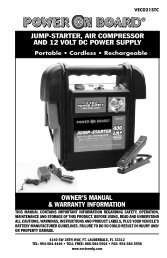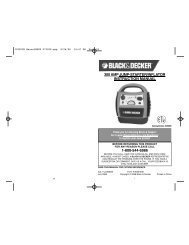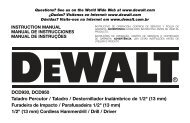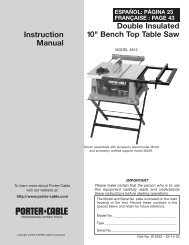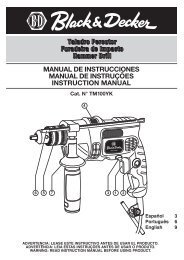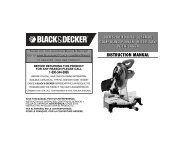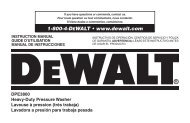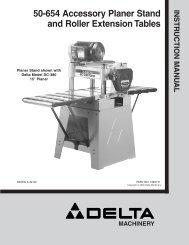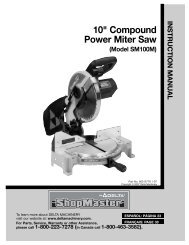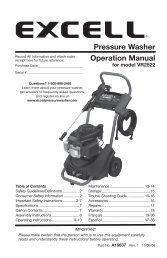Instruction manual Double Insulated Laminate Trimmers
Instruction manual Double Insulated Laminate Trimmers
Instruction manual Double Insulated Laminate Trimmers
You also want an ePaper? Increase the reach of your titles
YUMPU automatically turns print PDFs into web optimized ePapers that Google loves.
<strong>Instruction</strong><strong>manual</strong>ESPAÑOL: PÁGINA 25FRANÇAISE : PAGE 49<strong>Double</strong> <strong>Insulated</strong><strong>Laminate</strong> <strong>Trimmers</strong>MODEL 7319Tilt Base TrimmerMODEL 7310TrimmerMODEL 7312Offset TrimmerMODEL 7320UnderscribeTrimmer BaseUnderscribeAttachmentFor 97311To learn more about Porter-Cablevisit our website at:http://www.porter-cable.comIMPORTANTPlease make certain that the person who isto use this equipment carefully reads andunderstands these instructions beforestarting operations.The Model and Serial No. plate is located on the mainhousing of the tool. Record these numbers in thespaces below and retain for future reference.Model No. ______________________________________Type ___________________________________________Serial No. _______________________________________Copyright © 2004 Porter-Cable CorporationPart No. 911999 - 12-10-04
TABLE OF CONTENTSIMPORTANT SAFETY INSTRUCTIONS . . . . . . . . . . . . . . . . . . . . . . . . . .2SAFETY GUIDELINES . . . . . . . . . . . . . . . . . . . . . . . . . . . . . . . . . . . . . . . .3GENERAL SAFETY RULES . . . . . . . . . . . . . . . . . . . . . . . . . . . . . . . . . . .4ADDITIONAL SPECIFIC SAFETY RULES . . . . . . . . . . . . . . . . . . . . . . . .6FUNCTIONAL DESCRIPTION . . . . . . . . . . . . . . . . . . . . . . . . . . . . . . . .10CARTON CONTENTS . . . . . . . . . . . . . . . . . . . . . . . . . . . . . . . . . . . . . . .10OPERATION . . . . . . . . . . . . . . . . . . . . . . . . . . . . . . . . . . . . . . . . . . . . . .10TROUBLESHOOTING . . . . . . . . . . . . . . . . . . . . . . . . . . . . . . . . . . . . . .21MAINTENANCE . . . . . . . . . . . . . . . . . . . . . . . . . . . . . . . . . . . . . . . . . . . .22SERVICE . . . . . . . . . . . . . . . . . . . . . . . . . . . . . . . . . . . . . . . . . . . . . . . . .23ACCESSORIES . . . . . . . . . . . . . . . . . . . . . . . . . . . . . . . . . . . . . . . . . . . .23WARRANTY . . . . . . . . . . . . . . . . . . . . . . . . . . . . . . . . . . . . . . . . . . . . . . .24ESPAÑOL . . . . . . . . . . . . . . . . . . . . . . . . . . . . . . . . . . . . . . . . . . . . . . . .25FRANÇAISE . . . . . . . . . . . . . . . . . . . . . . . . . . . . . . . . . . . . . . . . . . . . . . .49SERVICE CENTER LOCATIONS . . . . . . . . . . . . . . . . . . . . . . .back coverIMPORTANT SAFETY INSTRUCTIONSRead and understand all warnings and operating instructionsbefore using any tool or equipment. When using tools or equipment, basicsafety precautions should always be followed to reduce the risk of personalinjury. Improper operation, maintenance or modification of tools or equipmentcould result in serious injury and property damage. There are certainapplications for which tools and equipment are designed. Porter-Cablestrongly recommends that this product NOT be modified and/or used for anyapplication other than for which it was designed.If you have any questions relative to its application DO NOT use the productuntil you have written Porter-Cable and we have advised you.Online contact form at www.porter-cable.comPostal Mail: Technical Service ManagerPorter-Cable Corporation4825 Highway 45 NorthJackson, TN 38305Information regarding the safe and proper operation of this tool is availablefrom the following sources:Power Tool Institute1300 Sumner Avenue, Cleveland, OH 44115-2851www.powertoolinstitute.orgNational Safety Council1121 Spring Lake Drive, Itasca, IL 60143-3201American National Standards Institute, 25 West 43rd Street, 4 floor, NewYork, NY 10036 www.ansi.org ANSI 01.1Safety Requirements forWoodworking Machines, and the U.S. Department of Labor regulationswww.osha.govSAVE THESE INSTRUCTIONS!2
SAFETY GUIDELINES - DEFINITIONSIt is important for you to read and understand this <strong>manual</strong>. The information itcontains relates to protecting YOUR SAFETY and PREVENTING PROBLEMS.The symbols below are used to help you recognize this information.indicates an imminently hazardous situation which, if notavoided, will result in death or serious injury.indicates a potentially hazardous situation which, if notavoided,could result in death or serious injury.indicates a potentially hazardous situation which, if notavoided,may result in minor or moderate injury.used without the safety alert symbol indicates potentiallyhazardous situation which, if not avoided, may result inproperty damage.CALIFORNIA PROPOSITION 65Some dust created by power sanding, sawing, grinding, drilling,and other construction activities contains chemicals known (to theState of California) to cause cancer, birth defects or other reproductive harm. Someexamples of these chemicals are:● lead from lead-based paints● crystalline silica from bricks and cement and other masonry products● arsenic and chromium from chemically-treated lumberYour risk from these exposures varies, depending on how often you do this typeof work. To reduce your exposure to these chemicals: work in a well ventilatedarea, and work with approved safety equipment, always wear NIOSH/OSHAapproved, properly fitting face mask or respirator when using such tools.3
Read all instructions. Failure to follow allinstructions listed below may result in electric shock, fire and/orserious injury. The term "power tool" in all of the warnings listedbelow refers to your mains-operated (corded) power tool orbattery-operated (cordless) power tool.SAVE THESE INSTRUCTIONS1) Work area safetyGENERAL SAFETY RULESa) Keep work area clean and well lit. Cluttered or dark areas inviteaccidents.b) Do not operate power tools in explosive atmospheres, such as in thepresence of flammable liquids, gases or dust. Power tools createsparks which may ignite the dust or fumes.c) Keep children and bystanders away while operating a power tool.Distractions can cause you to lose control.2) Electrical safetya) Power tool plugs must match the outlet. Never modify the plug in anyway. Do not use any adapter plugs with earthed (grounded) powertools. Unmodified plugs and matching outlets will reduce risk of electricshock.b) Avoid body contact with earthed or grounded surfaces such aspipes, radiators, ranges and refrigerators. There is an increased risk ofelectric shock if your body is earthed or grounded.c) Do not expose power tools to rain or wet conditions. Water entering apower tool will increase the risk of electric shock.d) Do not abuse the cord. Never use the cord for carrying, pulling orunplugging the power tool. Keep cord away from heat, oil, sharpedges or moving parts. Damaged or entangled cords increase the riskof electric shock.e) When operating a power tool outdoors, use an extension cordsuitable for outdoor use. Use of a cord suitable for outdoor use reducesthe risk of electric shock.3) Personal safetya) Stay alert, watch what you are doing and use common sense whenoperating a power tool. Do not use a power tool while you are tiredor under the influence of drugs, alcohol or medication. A moment ofinattention while operating power tools may result in serious personalinjury.b) Use safety equipment. Always wear eye protection. Safety equipmentsuch as dust mask, non-skid safety shoes, hard hat, or hearingprotection used for appropriate conditions will reduce personal injuries.c) Avoid accidental starting. Ensure the switch is in the off-positionbefore plugging in. Carrying power tools with your finger on the switchor plugging in power tools that have the switch on invites accidents.4
GENERAL SAFETY RULES continuedd) Remove any adjusting key or wrench before turning the power toolon. A wrench or a key left attached to a rotating part of the power toolmay result in personal injury.e) Do not overreach. Keep proper footing and balance at all times. Thisenables better control of the power tool in unexpected situations.f) Dress properly. Do not wear loose clothing or jewelry. Keep yourhair, clothing and gloves away from moving parts. Loose clothes,jewelry or long hair can be caught in moving parts.g) If devices are provided for the connection of dust extraction andcollection facilities, ensure these are connected and properly used.Use of these devices can reduce dust-related hazards.4) Power tool use and carea) Do not force the power tool. Use the correct power tool for yourapplication. The correct power tool will do the job better and safer at therate for which it was designed.b) Do not use the power tool if the switch does not turn it on and off.Any power tool that cannot be controlled with the switch is dangerousand must be repaired.c) Disconnect the plug from the power source before making anyadjustments, changing accessories, or storing power tools. Suchpreventive safety measures reduce the risk of starting the power toolaccidentally.d) Store idle power tools out of the reach of children and do not allowpersons unfamiliar with the power tool or these instructions tooperate the power tool. Power tools are dangerous in the hands ofuntrained users.e) Maintain power tools. Check for misalignment or binding of movingparts, breakage of parts and any other condition that may affect thepower tools operation. If damaged, have the power tool repairedbefore use. Many accidents are caused by poorly maintained powertools.f) Keep cutting tools sharp and clean. Properly maintained cutting toolswith sharp cutting edges are less likely to bind and are easier to control.g) Use the power tool, accessories and tool bits etc., in accordancewith these instructions and in the manner intended for theparticular type of power tool, taking into account the workingconditions and the work to be performed. Use of the power tool foroperations different from those intended could result in a hazardoussituation.5) Servicea) Have your power tool serviced by a qualified repair person using onlyidentical replacement parts. This will ensure that the safety of thepower tool is maintained.5
ADDITIONAL SPECIFIC SAFETY RULES1. HOLD POWER TOOLS BY INSULATED GRIPPING SURFACES WHENPERFORMING AN OPERATION WHERE THE CUTTING TOOL MAYCONTACT HIDDEN WIRING OR ITS OWN CORD. Contact with a "live"wire will make exposed metal parts of the tool "live" and shock the operator.2. USE CLAMPS OR OTHER PRACTICAL WAY TO SECURE ANDSUPPORT THE WORKPIECE TO A STABLE PLATFORM. Holding thework by hand or against your body is unstable and may lead to loss ofcontrol.3. DISCONNECT TOOL FROM POWER SOURCE before makingadjustments or changing bits.4. TIGHTEN COLLET NUT securely to prevent the bit from slipping.5. USE A CLAMP or some other device to hold the workpiece rigidly in position.and clear the path of the tool of obstructions.6. CHECK TO SEE THAT THE CORD will not “hang up” during trimmingoperation.7. CLEAR THE TRIMMER BIT AREA before starting motor.8. MAINTAIN FIRM GRIP on trimmer to resist starting torque.9. KEEP HANDS CLEAR OF CUTTER when motor is running to preventpersonal injury.10. KEEP CUTTING PRESSURE CONSTANT. Do not overload motor.11. LET THE MOTOR COME TO A COMPLETE STOP before putting the tooldown.12. NEVER TOUCH router bits after use. They may be extremely hot.13. NEVER TIGHTEN COLLET NUT without a bit.14. DO NOT USE LAMINATE TRIMMER MOTOR WITHOUT THELAMINATE TRIMMER BASE INSTALLED. Loss of control could result,causing personal injury or damage to work.15. WEAR EYE AND HEARING PROTECTION. ALWAYS USE SAFETYGLASSES. Everyday eyeglasses are NOT safety glasses. USE CERTIFIEDSAFETY EQUIPMENT. Eye protection equipment should comply with ANSIZ87.1 standards. Hearing equipment should comply with ANSI S3.19standards.16. USE OF THIS TOOL CAN GENERATE AND DISBURSEDUST OR OTHER AIRBORNE PARTICLES, INCLUDING WOOD DUST,CRYSTALLINE SILICA DUST AND ASBESTOS DUST. Direct particlesaway from face and body. Always operate tool in well ventilated area andprovide for proper dust removal. Use dust collection system whereverpossible. Exposure to the dust may cause serious and permanentrespiratory or other injury, including silicosis (a serious lung disease),cancer, and death. Avoid breathing the dust, and avoid prolonged contactwith dust. Allowing dust to get into your mouth or eyes, or lay on your skinmay promote absorption of harmful material. Always use properly fittingNIOSH/OSHA approved respiratory protection appropriate for the dustexposure, and wash exposed areas with soap and water.6
NOTES7
SYMBOLDEFINITIONV ........................ voltsA ........................ amperesHz ........................ hertzW ........................ wattskW ........................ kilowattsF ........................ faradsµF ........................ microfaradsl ........................ litresg ........................ gramskg ........................ kilogramsbar ........................ barsPa ........................ pascalsh ........................ hoursmin ........................ minutess ........................ secondsn 0 ........................ no-load speed…/min or …min- 1 ......... Revolutions or reciprocations per minuteor d.c. ................ direct currentor a.c. ................ alternating current2 ........................ two-phase alternating current2N ........................ two-phase alternating current with neutral3 ........................ three-phase alternating current3N ........................ three-phase alternating current with neutral........................ rated current of the appropriate fuse-link in amperes........................ time-lag miniature fuse-link where X is the symbolfor the time/current characteristic, as given in IEC 60127........................ protective earth........................ class II toolIPXX ........................ IP symbolSAVE THESE INSTRUCTIONS!8
MOTORMany Porter-Cable tools will operate on either D.C., or single phase 25 to 60cycle A.C. current and voltage within plus or minus 5 percent of that shown onthe specification plate on the tool. Several models, however, are designed forA.C. current only. Refer to the specification plate on your tool for proper voltageand current rating.Do not operate your tool on a current on which the voltage is notwithin correct limits. Do not operate tools rated A.C. only on D.C.current. To do so may seriously damage the tool.EXTENSION CORD SELECTIONIf an extension cord is used, make sure the conductor size is large enough toprevent excessive voltage drop which will cause loss of power and possiblemotor damage. A table of recommended extension cord sizes will be found inthis section. This table is based on limiting line voltage drop to 5 volts (10 voltsfor 230 volts) at 150% of rated amperes.If an extension cord is to be used outdoors it must be marked with the suffix W-Aor W following the cord type designation. For example – SJTW-A to indicate it isacceptable for outdoor use.RECOMMENDED EXTENSION CORD SIZES FOR USE WITH PORTABLE ELECTRIC TOOLSLength of Cord in Feet115V 25 Ft. 50 Ft. 100 Ft. 150 Ft. 200 Ft. 250 Ft. 300 Ft. 400 Ft. 500 Ft.230V 50 Ft. 100 Ft. 200 Ft. 300 Ft. 400 Ft. 500 Ft. 600 Ft. 800 Ft. 1000 Ft.0-2 18 18 18 16 16 14 14 12 122-3 18 18 16 14 14 12 12 10 103-4 18 18 16 14 12 12 10 10 84-5 18 18 14 12 12 10 10 8 85-6 18 16 14 12 10 10 8 8 66-8 18 16 12 10 10 8 6 6 68-10 18 14 12 10 8 8 6 6 410-12 16 14 10 8 8 6 6 4 412-14 16 12 10 8 6 6 6 4 214-16 16 12 10 8 6 6 4 4 216-18 14 12 8 8 6 4 4 2 218-20 14 12 8 6 6 4 4 2 2Nameplate Ampere Rating9
FUNCTIONAL DESCRIPTIONFOREWORDPorter-Cable <strong>Laminate</strong> <strong>Trimmers</strong> are designed for flush and bevel trimminglaminated plastics, phenolics, and other similar materials having a bondingagent too hard to be trimmed with ordinary tools.The Tilt-Base model allows trimming into corners inaccessible to standardtrimmers and to trim laminated surfaces joining at angles of 45° to 90°. Thisfeature eliminates the need for hand-trimming in many applications.The Off-Set Base Trimmer is designed for trimming into the corner of aback splash and trimming narrow ledges which are already mountedagainst a wall or another surface.The Underscribe Base is designed for making accurate “butt” joints inlaminated plastics, phenolics and other similar materials. The UnderscribeBase is used with the Model 7301 Trimmer Motor and the 43109 Trim Bit.SELECTING THE BITThese trimmers are equipped with a 1 /4" diameter collet to accept laminatetrimming bits having 1 /4" diameter shanks. Bits are available as anaccessory.CARTON CONTENTS1. Trimmer motor2. Trimmer base (or bases, if a kit is purchased)3. Wrench (or wrenches, if a kit is purchased)MODEL 7301 MOTOR UNITAll laminate trimmers covered by this<strong>manual</strong> incorporate Model 7301Motor Unit and are operated asfollows:TO START AND STOP MOTORFig. 1 shows the location of thepower switch. When the switchactuator is in the upper position theswitch is “OFF”. When the actuator isin the lower position the switch is“ON”.OPERATIONFig. 1SWITCHMake sure switch is “OFF” andpower circuit voltage is the same as that shown on the specification plate ofthe trimmer motor. Connect trimmer to power circuit.GRASP TRIMMER FIRMLY TO RESIST STARTINGTORQUE AND MAKE SURE BIT IS CLEAR OFWORKPIECE AND FOREIGN OBJECTS.Slide switch to “ON” position to start motor. Slide switch to “OFF” positionto stop motor.10
TO AVOID PERSONAL INJURY OR DAMAGE TO FINISHEDWORK ALWAYS ALLOW THE MOTOR TO COME TO ACOMPLETE STOP BEFORE SETTING TRIMMER DOWN.TO INSTALL BITDISCONNECT TOOL FROM POWER SOURCE.1. On Models 7310 and 7319 bits may be installed with the motor uniteither assembled or removed from the base. See instructions under Model7312 for installing the bit in the OFFSET trimmer. See instructions underModel 7320 for installing the bit in the UNDERSCRIBE trimmer.2. Clean and insert shank of bit into collet until end of shank bottoms. Thenwithdraw bit approximately 1 /16".3. Depress spindle lock (Fig. 2) and rotate collet nut clockwise by handuntil lock engages hole in motor spindle.4. While holding spindle lock engaged, tighten collet nut securely byturning clockwise using wrench provided.NEVER TIGHTEN COLLET WITHOUT BIT INSERTED,TO DO SO MAY CAUSE DAMAGE TO COLLET.BITCOLLET NUTSPINDLELOCKFig. 2TO REMOVE BITDISCONNECT TOOL FROM POWER SOURCE.NEVER TOUCH TRIMMER BITSIMMEDIATELY AFTER USE, AS THEY MAY BE HOT.1. On Model 7310 and 7319 bits may be removed with the motor unit eitherassembled or removed from base. See instructions under Model 7312 forremoving bits from the Offset Trimmer.2. Depress spindle lock and rotate collet nut counterclockwise by handuntil lock engages hole in motor spindle.3. While holding spindle lock engaged, loosen collet nut by turningcounterclockwise with wrench provided.4. If bit does not remove easily from collet, tap the collet nut with wrench torelease bit.MODEL 7310 TRIMMER ASSEMBLYModel 7310 Trimmer is completely assembled at the factory. The base isassembled to, or removed from Model 7301 Motor with base locking screw(Fig. 3).NOTE: There is a spring and a flat washer on the locking screw. Thespring is assembled with its small end against head of screw. Thewasher is assembled to the screw after the spring.11
ADJUSTING DEPTH OF CUTDISCONNECT TOOL FROM POWER SOURCE.1. Loosen base locking screw (Fig. 3) approximately one-quarter turn.2. Turn depth adjusting wheel (Fig. 3) clockwise, looking at top of wheel,to raise cutter reducing depth of cut or counterclockwise to lower cutter forincreasing depth of cut.3. Tighten base locking screw securely and make a test cut in scrapmaterial and check depth of cut.4. Repeat steps 1 through 3 until desired depth of cut is achieved.LOCKINGSCREW SPRING WASHERDEPTH ADJUSTINGWHEELFig. 3ADJUSTING SUB-BASE ALIGNMENTApplications using a templet guide require the bit to be centered within theguide. This, in turn, requires the center hole in the sub-base to be in linewith the collet of the motor unit. Your model has an adjustable sub-basewhich has been aligned at the factory. If the sub-base has been removedand/or readjustment is required, proceed as follows:DISCONNECT TOOL FROM POWER SOURCE.1. Install 42054 Templet Guide (available as an accessory) to the subbase andtighten securely.2. Loosen sub-base mounting screws just enough to allow sub-base to move onbase.3. Install a straight 1 /4" diameter bit in collet of motor unit and tighten securely.4. Assemble motor unit to base, align hole in templet guide with 1 /4" diameter bitand adjust depth of cut so that bit extends through templet guide. Tighten motor unitin base.5. Tighten sub-base mounting screws securely.73100 EDGE GUIDE KITThe Model 73100 Edge Guide Kit is available (as an accessory), for use withthe Model 310 trimmer. The 73100 is designed for use with non-piloted bits,on curved or straight applications. Non-piloted bits can produce a 90°straight cut, a 10° bevel cut, or a 22° bevel cut. The kit (Fig. 4) contains:A – Base and roller guide - for flush or bevel trimmingB – Edge guide – for flush trimmingC – Edge guide – for bevel trimmingD – Straight edge guide – for straight trimmingE – Guide setting gaugeF – Mounting screwsG – WrenchDISCONNECT TOOL FROM POWER SOURCE.12
A B C D E F GFig. 4ASSEMBLING AND ADJUSTING BASE AND ROLLER GUIDE1. Remove power unit from base unit (see “TO INSTALL BIT”), and install the bit.2. The base and roller guide (A) Fig. 4, is assembled at the factory. Toassemble, remove a sub-base mounting screw (A) Fig. 5 and insert alignment pinin guide base into hole (C) in bottom of trimmer sub-base. Fasten with twomounting screws (F) Fig. 4, as shown in Fig. 5A. Do not tighten at this time.3. Install proper bit as outlined under “TO INSTALL BIT.” Then, install motor tobase and adjust depth of cut (see “ADJUSTING DEPTH OF CUT”).4. Align roller guide with bit by loosening locking screw (Fig. 5A) and turningadjusting screw, with hex wrench provided, until guide is in desired location.NOTE: Guide mounting holes are oversized allowing guide to berotated on alignment pin to align guide roller with bit.5. For making flush cuts align roller guide with straight portion of bit. Forbevel cuts, adjust cutting depth so that only the bevel portion of bit projectsthrough trimmer base and adjust roller guide to produce desired amount ofbevel.6. Tighten all screws and make a trial cut on scrap material to checkalignment. Readjust if necessary.ADJUSTINGSCREWLOCKING SCREWMOUNTINGSCREWACFig. 5FLUSH TRIMMING1. DISCONNECT TOOL FROM POWER SOURCE.2. Attach base and guide to trimmer as outlined under ASSEMBLING ANDADJUSTING BASE AND ROLLER.3. Remove roller guide and replace with flush trimming guide (B) Fig. 4.This guide may be identified by the molded on letter “F”. The stud on the endof this guide must face toward the trimmer base.4. Install guide setting gauge (E) Fig. 4, into trimmer collet (see TO INSTALLBIT). Install trimmer motor to base. Adjust guide so that hole in end of gaugemay be positioned over the guide stud.13Fig. 5A
5. Remove guide setting gauge from trimmer and install flush trimming bit.6. Adjust depth of cut so that the straight portion of the bit extends belowthe trimmer base at least the thickness of the material to be trimmed.7. Make a trial cut on scrap material. Readjust if necessary.BEVEL TRIMMING1. Follow Steps 1 through 5 under FLUSH TRIMMING, except install beveltrimming guide (C) Fig. 4. This guide is identified by the letter “B” moldedonto it.2. Adjust depth of cut so that only the bevel portion of the bit extendsbelow trimmer base at least the thickness of the material to be trimmed.3. Make a trial cut on scrap material to check alignment. Readjust ifnecessary.USING STRAIGHT EDGE GUIDEThe straight edge guide (D) Fig. 4, maybe used with either bit for trimmingstraight edges.Assemble it to the guide base and adjust similar to the other guides.MODEL 7319 TILT BASE TRIMMER ASSEMBLYModel 7319 Tilt Base Trimmer is completely assembled at the factory. Thebase is assembled or removed from Model 7301 motor with base lockingscrew (A) Fig. 6.NOTE: There is a flat washer (B) Fig. 6, on the locking screw.Model 7319 Tilt Base is designed for use with 43216PC flush trim bitfor trimming into corners. It may also be used with other “self pilot”trim bits for conventional trimming at 90° setting.CDABFig. 6ADJUSTING DEPTH OF CUTDISCONNECT TOOL FROM POWER SOURCE.Loosen base locking screw and move motor unit up or down todecrease or increase depth of cut.It may be necessary with some bits to withdraw bit fromcollet to obtain maximum depth of cut. When doing this14
e sure at least 1 /2" of bit shank is engaged in collet. Do not use bitsthat result in having less than 1 /2" of bit shank engaged in collet. Todo so may cause poor gripping of collet resulting in loose bit anddamage to work, or personal injury should the bit come out of collet.ADJUSTING TILT1. Loosen two tilt locking screws (C) Fig. 6, (one on each side of base)using wrench provided.2. Tilt base aligning index mark (D) Fig. 6, with desired angle and tightensecurely.3. Make a trial cut on scrap material to check alignment. Readjust ifnecessary.MODEL 7312 OFFSET TRIMMER ASSEMBLYModel 7312 Offset Trimmer is completely assembled at the factory. The offsetbase is assembled to Model 7301 Motor as outlined below. Model 7312Offset Trimmer can be disassembled by reversing the following assemblyinstructions.ASSEMBLING OFFSET BASE TO MOTORDISCONNECT TOOL FROM POWER SOURCE.1. Remove collet nut and collet from motor unit.2. Assemble drive pulley (A) Fig. 7, to motor spindle and tighten securely.3. Use a phillips screwdriver to remove the three sub-base mountingscrews (A) Fig. 8, from the base, and remove the sub-base.4. Position the base to the motor and drive pulley assembly (fromstep 2). Be sure that the motor drive pulley engages the drive belt (inside thebase housing).5. Secure the motor to the base (see Fig. 9), with the thumbscrew (A),spring (B), and washer (C).6. Locate the #6-32 × 3 /8" screw from the hardware package. Use a phillipsscrewdriver to install this screw (D), as shown in Fig. 9. Tighten securely.7. Clean collet nut and collet, and assemble to the spindle in the offsetbase. DO NOT TIGHTEN COLLET NUT AT THIS TIME. Tightening the colletnut without a bit installed in the collet is likely to damage the collet.8. Position sub-base to base housing and secure with the three screws thatwere removed in step 3.AAAASUB-BASEFig. 7 Fig. 815
TO INSTALL & REMOVE BITDISCONNECT TOOL FROMPOWER SOURCE.1. Insert long portion of hex wrench(furnished) through spindle lock hole (see Fig.10) so that wrench protrudes from both sidesof base housing. It may be necessary to rotatespindle by hand to align hole in spindle withholes in housing.2. Clean and insert bit shank into collet.Tighten collet nut securely with collet wrench.NEVER TIGHTEN OR LOOSEN COLLET NUTWITH SPINDLE LOCK ENGAGED IN MOTORSHAFT. TO DO SO MAY DAMAGE DRIVEBELT.3. To remove bit, reverse above procedure.If bit does not remove easily, tap the bit shankwith wrench to release bit.NEVER TIGHTEN COLLETWITHOUT BIT INSERTED, TO DOSO MAY CAUSE DAMAGE TOCOLLET.Fig. 9DCBAADJUSTING DEPTH OF CUTDISCONNECT TOOLFROM POWERSOURCE.1. Loosen bit in collet (See TOINSTALL & REMOVE BIT).2. Position hex wrench (furnished)to depth adjusting screw (SeeFig.11).3. Hold spindle with fingers and apply light upward pressure on bit (tomaintain contact between bit shank and adjusting screw) while turning hexwrench to adjust bit exposure. Turn screw counter-clockwise to increaseexposure; turn screw clockwise to decrease exposure.4. When using long shank bits: The distance from the bottom of the subbaseto the collet may be increased (approximately 3 /16") by turning the subbaseover (See Fig.12):A. Remove three sub-basemounting screws.B. Turn sub-base over andre-attach using screwsremoved in step A.OPERATION1. Material to be trimmed mustoverhang the base material by atleast 1 /8".2. ALWAYS WEARSAFETY GLASSES WHILEOPERATING ALAMINATE TRIMMER.HEXWRENCHSPINDLEFig. 10Fig. 11HEXWRENCH16
SUB-BASEINVERTED3 /16"➤➤Fig. 123. DISCONNECT TOOL FROM POWER SOURCE.4. Firmly grasp motor housing beingsure switch is in the “OFF” position.5. Verify bit is clear of foreign objectsand cord will not “hang up” on anyobstructions.6. Be sure workpiece is firmly held inplace. Use clamps where necessary tosecure workpiece.7. Plug in power supply cord. Be alertto resist starting torque of motor. Turnmotor “ON”.8. Allow motor to reach “full speed”.Fig. 13Place base of trimmer on surface to be trimmed and feed into work until bitpilot contacts base material. When guiding on a previously laminatedsurface, always wax or lubricate the area that trimmer will guide against.NOTE: While operating trimmer with tilt base at any tilt setting otherthan “0” degrees, the long side of the base must be keptperpendicular to the piloting surface to prevent possible workspoilage.9. Feed from left to right with a smooth steady motion (See Fig. 13).10. At completion of trimming operation, turn switch “OFF”. Allow motor tocome to a complete stop before laying trimmer down.17
TYPICAL APPLICATIONSTRIMMING 3 /4" IN-AND-OUT TRIMMING SCRIBING OFVERTICAL BACKSPLASH OF INSTALLED CORNER BACKSPLASH TO WALLAPPLICATION – Trimming front edge of3 /4" vertical backsplash. This is an operationstandard trimmers with round orsquare bases are unable to do withoutthe use of a special bit.APPLICATION – Trimming into andout of installed backsplash cornerwith little or no hand trimmingrequired.APPLICATION – Accurately scribing the backside of a preassembled panel or post-formedbacksplash. Once the lip is accurately scribed,the trimmed portion is then pushed against thewall and mated exactly.Triangular baseenables completecorner trimmingwith backsplashin place.Front edgeof trimmeris guidedagainstwall.Self-piloted bitguides trimmer forone-pass trimmingevery time.Triangular baseenables trimming withbacksplash in place.Self-piloted bitfollows everytrimmer movementto create exactreproduction of wallsurface in one pass!Maintain 3 /4" separationfrom wall for scribing.OPERATION – Trimming 3 /4" backsplashwith the new Porter-Cable Offset <strong>Laminate</strong>Trimmer fitted with a solid carbide selfpilotedbit.OPERATION – The new Porter-CableOffset Trimmer will trim into and outof 90° corners with ease using selfpilotedbit.OPERATION – The guide assembly must beremoved. Using the self-piloted bit, thePorter-Cable Offset Trimmer scribesaccurately to the wall surface.Trims odd angledcorners less thanor greater than90°.Trims up tovertical surfaces.UNDERSCRIBE 7320 TRIMMER ASSEMBLYThe Underscribe Trimmer Base is assembled to the Model 7301 TrimmerMotor as follows:NOTE: The 43109 Trim Bit must be installed into the Trimmer Motor beforeattaching the motor to the Underscribe Base.DISCONNECT TOOL FROM POWER SOURCE.1. Clean and insert shank of bit (A) Fig. 14, into collet until end of shank18
ottoms. Then pull bit outapproximately 1 /8".B2. Depress spindle lock (B) Fig. 14,and rotate collet nut (C) clockwise byAhand until lock engages hole in motorspindle.3. While holding spindle lockengaged, tighten collet nut securely byturning clockwise using wrenchprovided.CNEVER TIGHTEN COLLETWITHOUT BIT INSERTED, TO DO SOMAY CAUSE DAMAGE TO COLLET.Fig. 144. Position base (A) Fig. 15, to motor(B) and secure using locking screw (E), spring (D) and washer (C).NOTE: Orient spring with small end against head of locking screw.5. Align the two holes in the undersciribe attachment (G) Fig. 15, with thetwo holes in the base (A).6. Attach the underscribe attachment (G) Fig. 15, to the base (A) with twoscrews (H) and eccentric washer (J).ADJUSTING BIT EXPOSUREDISCONNECT TOOL FROM POWER SOURCE.1. Loosen base locking screw (E) Fig. 15, approximately one-quarter of aturn.2. Turn depth adjusting wheel (F) Fig. 15, counterclockwise (looking at topof wheel) to lower bit until it just touches the guide plate.3. Firmly tighten locking screw (E).ABEDCJGFHFig. 15ADJUSTING GUIDE PLATEThe Underscribe Trimmer Base is equipped with an adjustable guide plate(see Fig. 16). The guide plate is adjusted by rotating the eccentric, using aspecial wrench that is supplied with the Trimmer Base. To adjust guide,proceed as follows:1. Make a trial cut using scrap material and check fit.2. DISCONNECT TOOL FROM POWER SOURCE.3. Turn eccentric to correct fit-up:If joint is TOO LOOSE (crack between the two pieces of laminate), turneccentric clockwise.19
If joint to TOO TIGHT (laminatewill not snap into place), turneccentric counterclockwise.4. Repeat Steps 1 through 3 asrequired to achieve a good fitup.USING THEUNDERSCRIBETRIMMERFig. 16The bottom plate of theUnderscribe Trimmer has a guide lip (see Fig. 17). This guide lip is movedalong an installed piece of laminate as the trimmer bit cuts the mating pieceof laminate.The “butt” joint is commonly used in the construction of face frames.Proceed as follows to install a laminate covering on a face frame. Similarprocedures would be required for making any “butt” joint.ALWAYS WEARSAFETY GLASSES WHILEOPERATING A LAMINATETRIMMER.AABCDEFTrimmer BaseSub-BaseInstalled laminateGuide LipBit<strong>Laminate</strong>BCFig. 17DEF1. Cut the pieces of laminate covering to rough size and apply contactcement to the face frame and the laminate pieces in the normal manner.NOTE: Cut the rail covering approximately 1" longer than the rail (toallow material for trimming).2. Apply the laminate to all stiles.3. Position the laminate to a rail with at least 1 /4", and no more than 3 /4",overlapping each stile (see Fig. 18). Use a roller to secure the center sectionof the laminate to therail. Leave at least 4" ofthe laminate loose, atboth ends of the rail(Do not roll down).4. Securely clampthe face frameassembly to theworktable to preventmovement during thetrimming operation.20Fig. 18OVERLAP1 /4" TO 3 /4"
Fig. 19 Fig. 205. Position the underscribe trimmer onto the face frame so that the top(see Fig. 19), is against the edge of the stile.NOTE: The trimmer should be to the right of the rail, so that thecutting action will move from right to left (see Fig. 19).6. Verify that bit is clear of foreign objects and that cord will not hang onany obstructions.7. Grasp motor firmly to resist starting torque and move switch button toON position.8. Allow motor to reach full-speed. Feed trimmer right to left with a smoothsteady motion.NOTE: The tapered edge of the underscribe base will slideunderneath the rail covering, lifting the laminate into the cutter.9. After completing the cut, move the switch button to the OFF positionand allow the motor to come to a complete stop before laying the trimmerdown.10. Press the rail end into position and roll down.11. Repeat the above process as necessary to complete the face frame.TROUBLESHOOTING GUIDEFor assistance with your tool, visit our website at www.porter-cable.com for alist of service centers or call the Porter-Cable help line at 1-800-487-8665.21
MAINTENANCEKEEP TOOL CLEANPeriodically blow out all air passages with dry compressed air. All plastic partsshould be cleaned with a soft damp cloth. NEVER use solvents to clean plasticparts. They could possibly dissolve or otherwise damage the material.Wear ANSI Z87.1 safety glasses while using compressed air.FAILURE TO STARTShould your tool fail to start, check to make sure the prongs on the cord plug aremaking good contact in the outlet. Also, check for blown fuses or open circuitbreakers in the line.LUBRICATIONThis tool has been lubricated with a sufficient amount of high grade lubricant forthe life of the unit under normal operating conditions. No further lubrication isnecessary.BRUSH INSPECTION (If applicable)For your continued safety and electrical protection, brush inspection andreplacement on this tool should ONLY be performed by an AUTHORIZEDPORTER-CABLE SERVICE STATION or a PORTER-CABLE•DELTA FACTORYSERVICE CENTER.At approximately 100 hours of use, take or send your tool to your nearestauthorized Porter-Cable Service Station to be thoroughly cleaned and inspected.Have worn parts replaced and lubricated with fresh lubricant. Have new brushesinstalled, and test the tool for performance.Any loss of power before the above maintenance check may indicate the needfor immediate servicing of your tool. DO NOT CONTINUE TO OPERATE TOOLUNDER THIS CONDITION. If proper operating voltage is present, return your toolto the service station for immediate service.22
REPLACEMENT PARTSSERVICEWhen servicing use only identical replacement parts.SERVICE AND REPAIRSAll quality tools will eventually require servicing or replacement of parts due towear from normal use. These operations, including brush inspection andreplacement, should ONLY be performed by either an AUTHORIZED PORTER-CABLE SERVICE STATION or a PORTER-CABLE•DELTA FACTORY SERVICECENTER. All repairs made by these agencies are fully guaranteed againstdefective material and workmanship. We cannot guarantee repairs made orattempted by anyone other than these agencies.Should you have any questions about your tool, feel free to write us at any time.In any communications, please give all information shown on the nameplate ofyour tool (model number, type, serial number, etc.).ACCESSORIESA complete line of accessories is available from your Porter-Cable•DeltaSupplier, Porter-Cable•Delta Factory Service Centers, and Porter-CableAuthorized Service Stations. Please visit our Web Site www.porter-cable.comfor a catalog or for the name of your nearest supplier.Since accessories other than those offered by Porter-Cable•Delta have not been tested with this product, use ofsuch accessories could be hazardous. For safest operation,only Porter-Cable•Delta recommended accessories shouldbe used with this product.23
WARRANTYPORTER-CABLE LIMITEDONE YEAR WARRANTYPorter-Cable warrants its Professional Power Tools for a period of one year from the date of originalpurchase. We will repair or replace at our option, any part or parts of the product and accessoriescovered under this warranty which, after examination, proves to be defective in workmanship ormaterial during the warranty period. For repair or replacement return the complete tool or accessory,transportation prepaid, to your nearest Porter-Cable Service Center or Authorized Service Station.Proof of purchase may be required. This warranty does not apply to repair or replacement requireddue to misuse, abuse, normal wear and tear or repairs attempted or made by other than our ServiceCenters or Authorized Service Stations.ANY IMPLIED WARRANTY, INCLUDING THE IMPLIED WARRANTIES OF MERCHANTABILITY ANDFITNESS FOR A PARTICULAR PURPOSE, WILL LAST ONLY FOR ONE (1) YEAR FROM THE DATEOF PURCHASE.To obtain information on warranty performance please write to: PORTER-CABLE CORPORATION,4825 Highway 45 North, Jackson, Tennessee 38305; Attention: Product Service. THE FOREGOINGOBLIGATION IS PORTER-CABLE’S SOLE LIABILITY UNDER THIS OR ANY IMPLIED WARRANTYAND UNDER NO CIRCUMSTANCES SHALL PORTER-CABLE BE LIABLE FOR ANY INCIDENTALOR CONSEQUENTIAL DAMAGES. Some states do not allow limitations on how long an impliedwarranty lasts or the exclusion or limitation of incidental or consequential damages, so the abovelimitation or exclusion may not apply to you.This warranty gives you specific legal rights and you may also have other legal rights which varyfrom state to state.24
PORTER-CABLE • DELTA SERVICE CENTERS(CENTROS DE SERVICIO DE PORTER-CABLE • DELTA)(CENTRE DE SERVICE PORTER-CABLE • DELTA)Parts and Repair Service for Porter-Cable • Delta Power Tools are Available at These Locations(Obtenga Refaccion de Partes o Servicio para su Herramienta en los Siguientes Centros de Porter-Cable • Delta)(Locations où vous trouverez les pièces de rechange nécessaires ainsi qu’un service d’entretien)ARIZONATempe 85282 (Phoenix)2400 West Southern AvenueSuite 105Phone: (602) 437-1200Fax: (602) 437-2200CALIFORNIAOntario 91761 (Los Angeles)3949A East Guasti RoadPhone: (909) 390-5555Fax: (909) 390-5554San Diego 921117638 Clairemnot Blvd.Phone: (858) 277-9595Fax: (858) 277-9696San Leandro 94577 (Oakland)3039 Teagarden StreetPhone: (510) 357-9762Fax: (510) 357-7939COLORADOArvada 80003 (Denver)8175 Sheridan Blvd., Unit SPhone: (303) 487-1809Fax: (303) 487-1868FLORIDADavie 33314 (Miami)4343 South State Rd. 7 (441)Unit #107Phone: (954) 321-6635Fax: (954) 321-6638Tampa 336094538 W. Kennedy BoulevardPhone: (813) 877-9585Fax: (813) 289-7948Authorized Service Stations are located in many large cities. Telephone 800-487-8665 or 731-541-6042 for assistance locating one. Parts andaccessories for Porter-Cable • Delta products should be obtained by contacting any Porter-Cable • Delta Distributor, Authorized ServiceCenter, or Porter-Cable • Delta Factory Service Center. If you do not have access to any of these, call 888-848-5175 and you will be directed tothe nearest Porter-Cable • Delta Factory Service Center. Las Estaciones de Servicio Autorizadas están ubicadas en muchas grandes ciudades.Llame al 800-487-8665 ó al 731-541-6042 para obtener asistencia a fin de localizar una. Las piezas y los accesorios para los productos Porter-Cable • Delta deben obtenerse poniéndose en contacto con cualquier distribuidor Porter-Cable • Delta, Centro de Servicio Autorizado o Centrode Servicio de Fábrica Porter-Cable • Delta. Si no tiene acceso a ninguna de estas opciones, llame al 888-848-5175 y le dirigirán al Centro deServicio de Fábrica Porter-Cable • Delta más cercano. Des centres de service agréés sont situés dans beaucoup de grandes villes. Appelez au800-487-8665 ou au 731-541-6042 pour obtenir de l’aide pour en repérer un. Pour obtenir des pièces et accessoires pour les produits Porter-Cable • Delta, s’adresser à tout distributeur Porter-Cable • Delta, centre de service agréé ou centre de service d’usine Porter-Cable • Delta. Sivous n’avez accès à aucun de ces centres, appeler le 888-848-5175 et on vous dirigera vers le centre de service d’usine Porter-Cable • Delta leplus proche.CANADIAN PORTER-CABLE • DELTA SERVICE CENTERSALBERTABay 6, 2520-23rd St. N.E.Calgary, AlbertaT2E 8L2Phone: (403) 735-6166Fax: (403) 735-6144BRITISH COLUMBIA8520 Baxter PlaceBurnaby, B.C.V5A 4T8Phone: (604) 420-0102Fax: (604) 420-3522GEORGIAForest Park 30297 (Atlanta)5442 Frontage Road,Suite 112Phone: (404) 608-0006Fax: (404) 608-1123ILLINOISAddison 60101 (Chicago)400 South Rohlwing Rd.Phone: (630) 424-8805Fax: (630) 424-8895Woodridge 60517 (Chicago)2033 West 75th StreetPhone: (630) 910-9200Fax: (630) 910-0360MARYLANDElkridge 21075 (Baltimore)7397-102 Washington Blvd.Phone: (410) 799-9394Fax: (410) 799-9398MASSACHUSETTSFranklin 02038 (Boston)Franklin Industrial Park101E Constitution Blvd.Phone: (508) 520-8802Fax: (508) 528-8089MICHIGANMadison Heights 48071 (Detroit)30475 Stephenson HighwayPhone: (248) 597-5000Fax: (248) 597-5004MINNESOTAMinneapolis 554295522 Lakeland Avenue NorthPhone: (763) 561-9080Fax: (763) 561-0653MISSOURINorth Kansas City 641161141 Swift AvenuePhone: (816) 221-2070Fax: (816) 221-2897St. Louis 631197574 Watson RoadPhone: (314) 968-8950Fax: (314) 968-2790NEW YORKFlushing 11365-1595 (N.Y.C.)175-25 Horace Harding Expwy.Phone: (718) 225-2040Fax: (718) 423-9619NORTH CAROLINACharlotte 282709129 Monroe Road, Suite 115Phone: (704) 841-1176Fax: (704) 708-4625OHIOColumbus 432144560 Indianola AvenuePhone: (614) 263-0929Fax: (614) 263-1238MANITOBA1699 Dublin AvenueWinnipeg, ManitobaR3H 0H2Phone: (204) 633-9259Fax: (204) 632-1976ONTARIO505 Southgate DriveGuelph, OntarioN1H 6M7Phone: (519) 767-4132Fax: (519) 767-4131Cleveland 441258001 Sweet Valley DriveUnit #19Phone: (216) 447-9030Fax: (216) 447-3097OREGONPortland 972304916 NE 122 nd Ave.Phone: (503) 252-0107Fax: (503) 252-2123PENNSYLVANIAWillow Grove 19090 (Philadelphia)520 North York RoadPhone: (215) 658-1430Fax: (215) 658-1433TEXASCarrollton 75006 (Dallas)1300 Interstate 35 N, Suite 112Phone: (972) 446-2996Fax: (972) 446-8157Houston 770434321 Sam Houston Parkway, WestSuite 180Phone: (713) 983-9910Fax: (713) 983-6645WASHINGTONAuburn 98001(Seattle)3320 West Valley HWY, NorthBuilding D, Suite 111Phone: (253) 333-8353Fax: (253) 333-9613QUÉBEC1515 Ave.St-Jean Baptiste, Suite 160Québec, P.Q.G2E 5E2Phone: (418) 877-7112Fax: (418) 877-71231447, BeginSt-Laurent, (Mtl), P.Q.H4R 1V8Phone: (514) 336-8772Fax: (514) 336-3505The following are trademarks of PORTER-CABLE • DELTA (Las siguientes son marcas registradas de PORTER-CABLE • DELTA S.A.) (Lesmarques suivantes sont des marques de fabriquant de la PORTER-CABLE • DELTA): Auto-Set ® , BAMMER ® , B.O.S.S. ® , Builder’s Saw ® ,Contractor’s Saw ® , Contractor’s Saw II, Delta ® , DELTACRAFT ® , DELTAGRAM, Delta Series 2000, DURATRONIC, Emc², FLEX ® , FlyingChips, FRAME SAW ® , Grip Vac, Homecraft ® , INNOVATION THAT WORKS ® , Jet-Lock ® , JETSTREAM ® , ‘kickstand ® , LASERLOC ® , MICRO-SET ® , Micro-Set ® , MIDI LATHE ® , MORTEN, NETWORK, OMNIJIG ® , POCKET CUTTER ® , PORTA-BAND ® , PORTA-PLANE ® , PORTER-CABLE ® &(design), PORTER-CABLE ® PROFESSIONAL POWER TOOLS, PORTER-CABLE REDEFINING PERFORMANCE, Posi-Matic ® , Q-3 ® &(design), QUICKSAND ® &(design), QUICKSET, QUICKSET II ® , QUICKSET PLUS, RIPTIDE&(design), SAFE GUARD II ® , SAFE-LOC ® ,Sanding Center ® , SANDTRAP ® &(design), SAW BOSS ® , Sawbuck, Sidekick ® , SPEED-BLOC ® , SPEEDMATIC ® , SPEEDTRONIC ® , STAIR EASE ® ,The American Woodshop ® &(design), The Lumber Company ® &(design), THE PROFESSIONAL EDGE ® , THE PROFESSIONAL SELECT ® , THIN-LINE, TIGER ® , TIGER CUB ® , TIGER SAW ® , TORQBUSTER ® , TORQ-BUSTER ® , TRU-MATCH, TWIN-LITE ® , UNIGUARD ® , Unifence ® ,UNIFEEDER, Unihead ® , Uniplane, Unirip ® , Unisaw ® , Univise ® , Versa-Feeder ® , VERSA-PLANE ® , WHISPER SERIES ® ,WOODWORKER’S CHOICE.Trademarks noted with and ® are registered in the United States Patent and Trademark Office and may also be registered in other countries.Las Marcas Registradas con el signo de y ® son registradas por la Oficina de Registros y Patentes de los Estados Unidos y también puedenestar registradas en otros países. Marques déposées, indiquées par la lettre et ®, sont déposées au Bureau des brevets d’invention etmarques déposées aux Etats-Unis et pourraient être déposées aux autres pays.7.2-PTG-F-1



